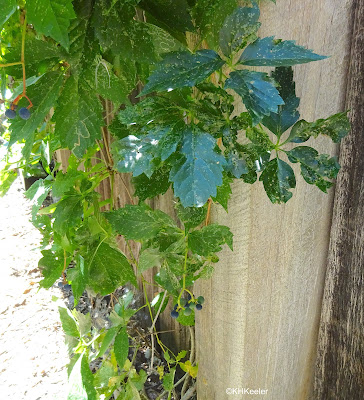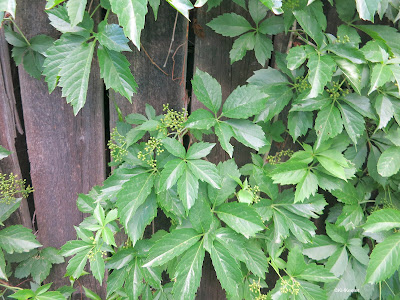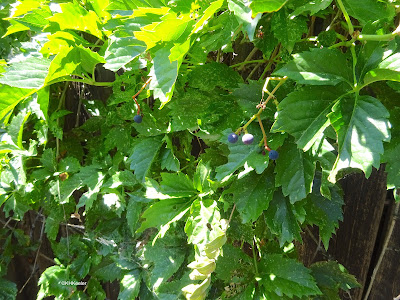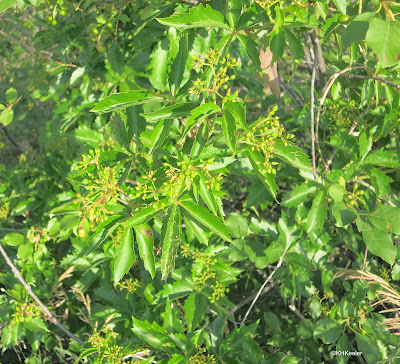 |
| woodbine, Parthenocissus vitacea |
They are big vines, common and hardy. I want to talk about the native American plants in the genus Parthenocissus. The best-known is Virginia creeper, Parthenocissus quinquefolia. It is native to eastern North America (Virginia!) but was long ago planted as a landscape plant, so it can be found from England to Australia. In the U.S., where it is found west of eastern Nebraska and in Canada, it is considered escape from cultivation.
Less well-known but more widespread in terms of places where it is native in the U.S., is woodbine or thicket creeper, Parthenocissus vitacea, also called Parthenocissus inserta. Woodbine is native to pretty much all of the US except the South, growing in rocky hillsides, ravines and along rivers and streams. The scientific community is split as to whether woodbine should be Parthenocissus vitacea or P. inserta. The Flora of North America, the U.S.D.A. Plants data base, Kew Gardens in England and the Flora of Colorado (2022) are all using P. vitacea. Wikipedia and iNaturalist go with P. inserta. It is the same plant. In a mess like this, if, like me, you don't see the issues that made the authorities choose different sides, you pick one authority and follow their decisions. My choice is the Flora of Colorado 2nd edition, so I'll call this plant Parthenocissus vitacea.
The U.S. has a third native species, seven-leaf creeper, Parthenocissus heptaphylla, found only in Texas, and there, only on the Edwards Plateau and Lampasas Cut Plain.
Parthenocissus is one of 17 genera in the grape family, Vitaceae. Like grapes (Vitus) they are big vines with inconspicuous flowers, small round fruits and broad leaves. Worldwide there are 12 recognized species within Parthenocissus; the ones not mentioned above native to Asia. Boston ivy, Parthenocissus tricuspidata is from Japan and China, named for Boston because it was planted there when introduced to North America and other people first saw it in Boston. (link to more details on Boston ivy).
Plant books sometimes give "creeper" as the general name for plants in the genus Parthenocissus. The problem with that is that creeper is often used for other, unrelated vines, such as trumpet creeper, Campsis radicans, in the catalpa family, Bignoniaceae. If you see "creeper" you can't assume it is a Virginia creeper relative.
Parthenocissus comes from the Greek parthenos, virgin, and kissos, ivy. The scientific name was given by a Frenchman, turning the French common name vigne vierge into Latin. "Virgin ivy" was likely meant to be read "ivy from Virginia." The species epithet quinquefolia means "5-leaves"because the big leaves have 5 lobes. The species epithet heptophylla means "7-leaves" and that is the distinctive characteristic of that species: the leaves have seven lobes. The species epithet vitacea means vine-like (how uninspired!). In Parthenocissus inserta, inserta means "inserted" but I haven't gone back to the 1870s German-and-Latin first description to see what is inserted. For Boston ivy, tricuspidata means "having three cusps (sharp points)", describing Boston ivy's leaves.
 |
These big vines climb with tendrils. Virginia creeper has suction pads on its tendrils so can climb stone or vertical walls. Woodbine rarely has the suction pads, so drapes from trees and fences but can't attach to smooth vertical surfaces.
The leaves contain raphides (little crystals of calcium oxalate) that irritate the skin of some people. The sap is particularly likely to cause a rash. Despite this, Virginia creeper and woodbine are host plants to literally dozens of native insects, including the Virginia creeper sphinx moth, the Achemon sphinx moth and the grapeleaf skelonizer. (The data I found was for Virginia creeper, woodbine seems seriously under-studied.)
Virginia creeper and woodbine are frequently taken for poison ivy (Toxicodendron radicans), probably because they are big vines. Poison ivy's leaves have three leaflets; Virginia creeper and woodbine have five.
The flowers are pale yellow or green and not very visible. They attract small bees that collect their pollen.
Both have fruit that turn black when ripe, often on red stems. The plants protect themselves with oxalic acid. Oxalic acid in small amounts is something people like; it provides that minor zing to spinach leaves, for example. But it contributes to kidney stones and is toxic in large amounts. Woodbine and Virginia creeper fruits contain enough oxalic acid that they are marked as poisonous to people and dogs. Generally they taste so bad that no one eats a second berry and they are toxic in quantity, not as a single berry. Meanwhile, they are very attractive to birds. Woodbine and Virginia creeper fruits draw lots of migratory birds, giving them energy for their long flights southward. (At least 35 species recorded). The seeds in the fruit grow well when excreted by the birds, distributing them and explaining the plant's abundance under fences, phone lines, and in thickets.
Native Americans across the continent made use of these plants. They were medicine for jaundice, part of poultices for swellings, and in a tonic for diarrhea. Montana Indians and Ramah Navajo ate the berries like grapes (likely woodbine not Virigina creeper given the species' distributions). Chippewa cut and peeled the stalks and boiled the shots to eat the sweet substance inside. Winabojo cooked and ate the roots. The Navajo planted woodbine by ramadas for shade. The Kiowa and Jemez made body paint, pink to purple, using the berries, for ceremonies.
 |
| woodbine, Parthenocissus vitacea |
People recommend Virginia creeper as a fast-growing attractive vine to, for example, provide privacy along a chain-link fence, but caution that it will need to be cut back regularly. Nobody mentions woodbine but it is very similar. My pictures are mainly of woodbine. I thought it was Virginia creeper because it was growing along my fences when I bought the property, as if it had been planted, but a closer look suggests it is woodbine. Woodbine is native to Colorado and I don't see it for sale much. Virginia creeper is planted in Colorado and may have naturalized but this is west of its native range. My woodbine seeds into all sorts of places around my yard--well, I'm glad to have the birds that dropped the seeds and I can pull up little plants invading my roses. It tolerates shade, can be a ground cover in troublesome spot, and feeds insects and birds. I am willing to cut it back as needed. Mainly, the plants drape my back fence. (The fall picture with the red leaves is not of my fence; I don't have that much woodbine. At least, not yet.)
Summarizing, woodbine and Virginia creeper are big native American vines that are excellent in feeding native birds and insects AND are very pretty plants.
Comments and corrections welcome.
References
Ackerfield, J. 2022. The Flora of Colorado. 2nd edition. BRIT Press, Fort Worth, TX.
Kew Gardens (Plants of the World Online) Parthenocissus inserta; Parthenocissus vitacea. link Accessed 9/15/23.
LoPresto, M. 2009. Virginia Creeper: Beautiful Vine, Abundant Food Source. Loudon Wildlife Conservancy. Volume 14, Issue 3. link Accessed 9/15/23.
Moerman, D. E. 1998. Native American Ethnobotany. Timber Press, Portland, OR. Online version: link
Missouri Plant Finder. Parthenocissus quinquefolia. link Accessed 9/16/23.
Spritzler, F. 2022. Oxylate (oxalic acid). Good or Bad? Healthline link Accessed 9/16/23.
Kathy Keeler, A Wandering Botanist
More at awanderingbotanist.com
Join me on Facebook: https://www.facebook.com/AWanderingBotanist




In Mallorca, Spain, we have similar plants too. Not the same, but really very similar.
ReplyDeleteIt is a good plant, with a fast development, and is very good for to cover walls, for example. Very nice on the gardens. This plant likes a lot the water too.